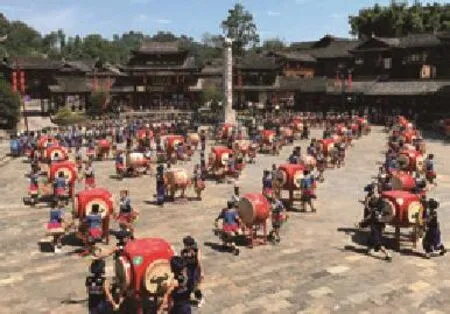Drum for Harvest
2016-09-26
Drum for Harvest

XINHUA
People of the Miao ethnic group play drums to celebrate the autumn harvest in Songtao Miao Ethnic Autonomous County, southwest China’s Guizhou Province, on September 2.
Another case in Huangshi,Hubei Province, saw police seize a man surnamed Hong and confiscate more than 16,000 copies of unlicensed publications intended for students. Hong had sold publications with a total value of 5 million yuan ($747,686) since 2011.
In other cases, police busted the illegal printing and sale of pirated books for children. Production and storage sites and illegal bookstores were closed and suspects involved were arrested.
Microbe Research
China has helped elevate microbe research in the past few years,according to a report on microbial resources released on September 6.
The report on China’s microbial resource development was issued by the World Data Center for Microorganisms and the microbial resource and data center under the Institute of Microbiology of the Chinese Academy of Sciences.
The total number of microbial strains preserved and shared by China’s 33 major microbial preservation centers is 182,000 at present,ranking fourth in the world, it said.
Meanwhile, the number of theses in the field published in 2015 grew 17.8 times from 2001, said the report, adding cited papers are also on the rise.
Microbe research is a rising field in bioscience and China should continue boosting the exploration and protection of its microbial resources, said Ma Juncai, Director of the microbial resource and data center.
Rural Roads Upgrade
Xinjiang Uygur Autonomous Region has spent 3.68 billion yuan ($557.5 million) to build and resurface 5,284 km of rural roads so far this year.
Xinjiang has spent 21.8 billion yuan ($3.264 billion) on 38,029 km of country road in the last five years,benefiting 5.59 million residents, the regional transportation authority said.
The autonomous region will continue to increase investment in rural road construction, as 60 villages are not yet connected to the road network, and 989 villages have poor roads.
Xinjiang, in the northwest of China, is about the size of Alaska. Road construction is difficult and expensive in the region’s mountainous southern part.
Crown Restoration
Chinese archaeologists have restored a 1,400-year-old royal crown,which belonged to the wife of Yang Guang, or Emperor Yang of the Sui Dynasty (581-618), the second and last monarch of the short-lived dynasty.
The crown was unearthed in the tomb of the queen, known as Empress Xiao, in 2012 in Yangzhou,east China’s Jiangsu Province.
It is the oldest official crown of a queen ever found in China. Archaeologists dug it out of a rotten wooden box near the queen’s coffin and sent it to a relic restoration lab with the Cultural Relic Protection Institute in northwest China’s Shaanxi Province.
Yang Junchang, a professor with Northwest Industrial University,who led the restoration project, said his team carefully cleared fragile bronze wires from the crown, inch by inch, to restore 13 flower decorations.
The flowers made of gilded bronze wires are very delicate with clear shapes of stalks, petals and stamen. The decorations are gold colored and flicker with movement.
The crown was made with a variety of materials, including bronze wire, gold, pearls, cotton and silk.
Shu Jiaping, head of the Yangzhou Institute of Archaeology,said that lab research had helped rediscover the materials and ancient techniques used for making a royal crown.
